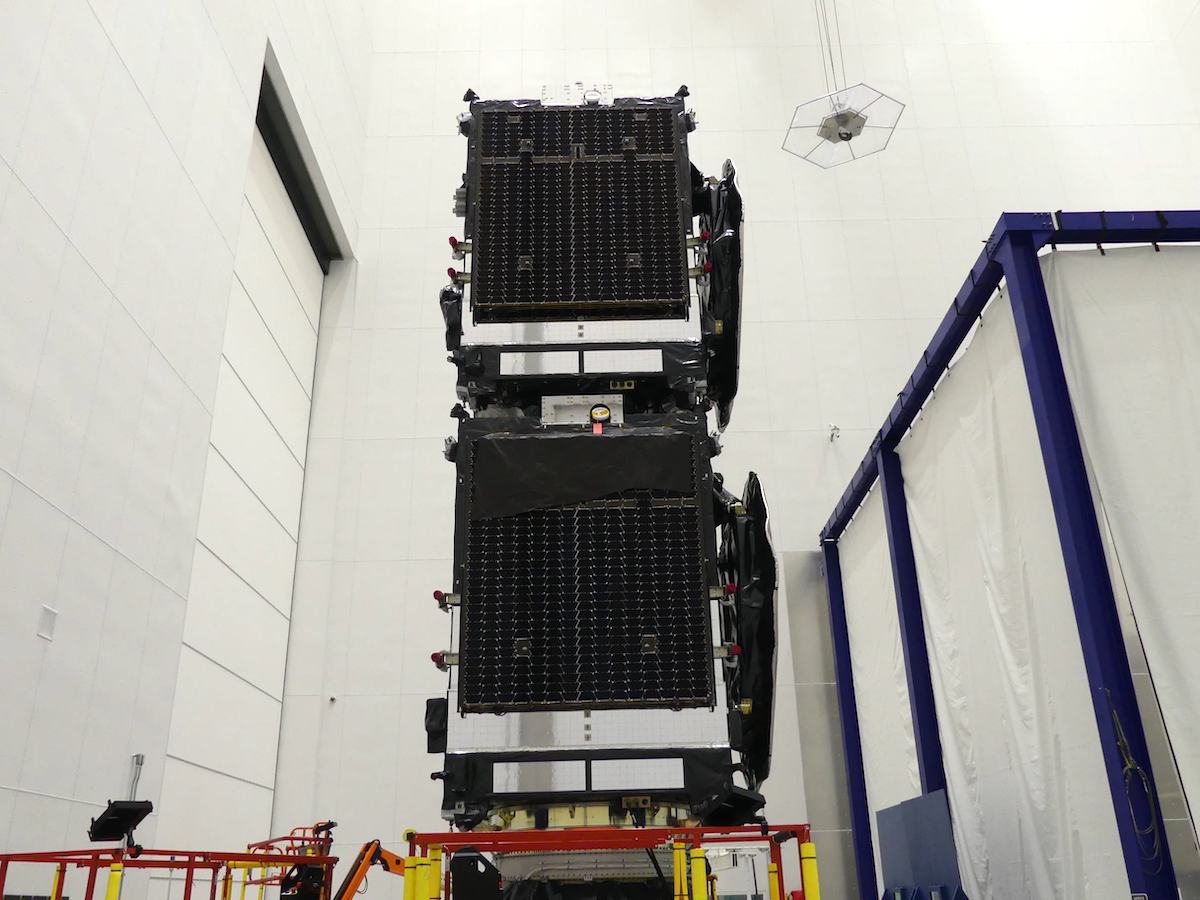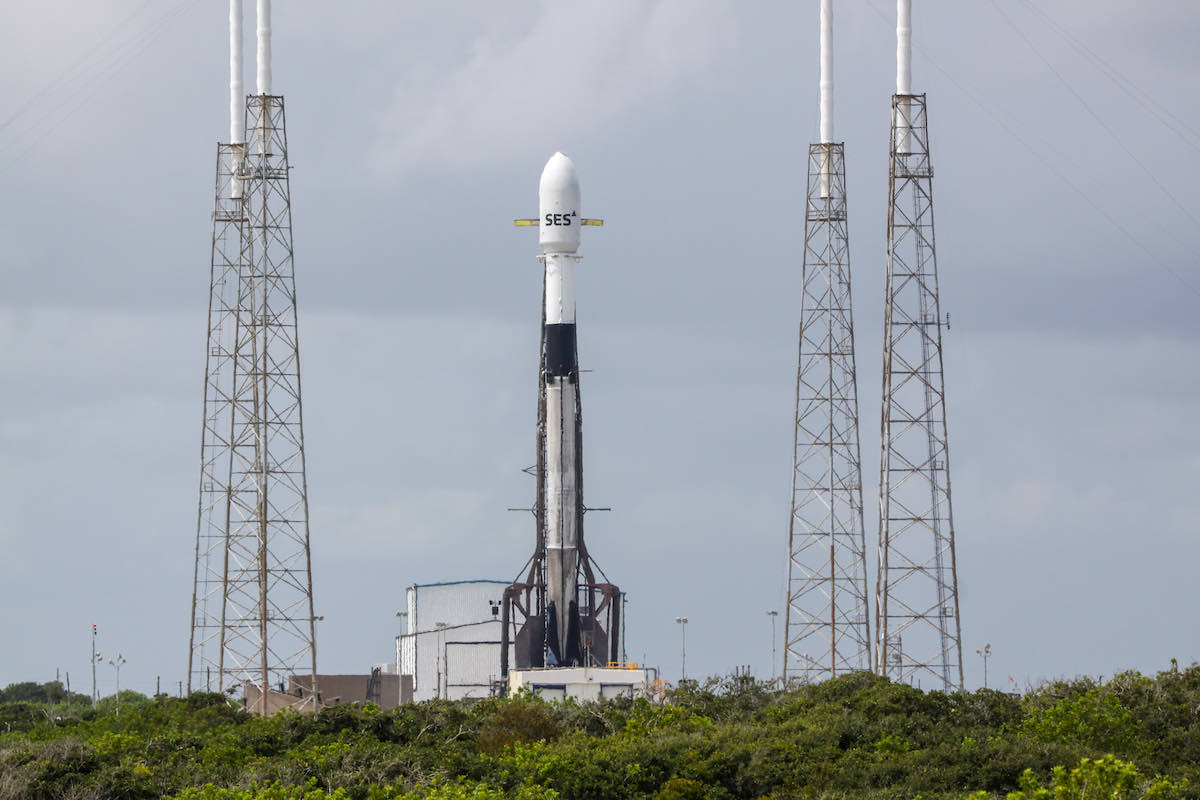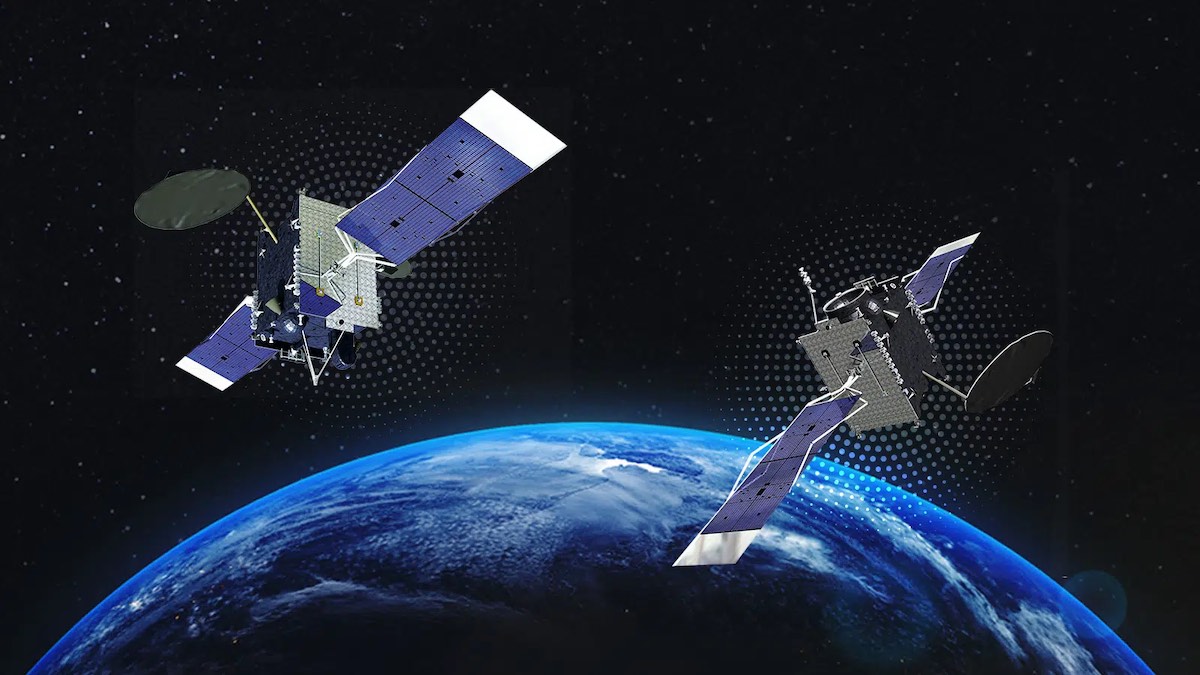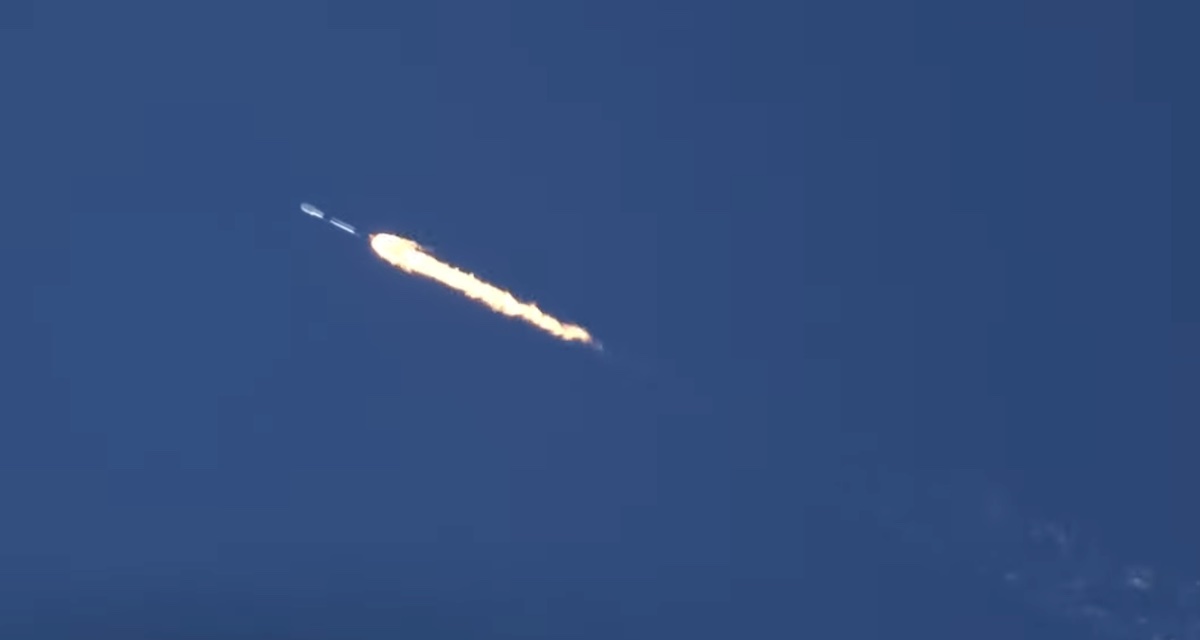Space News & Blog Articles
Dual satellite launch for Intelsat next on SpaceX’s launch schedule
 The Galaxy 33 and Galaxy 34 (top and bottom) satellites stacked in launch configuration at SpaceX’s payload processing facility at Cape Canaveral Space Force Station. Credit: Intelsat
The Galaxy 33 and Galaxy 34 (top and bottom) satellites stacked in launch configuration at SpaceX’s payload processing facility at Cape Canaveral Space Force Station. Credit: Intelsat
For the third time in 31 hours, SpaceX is poised to fire a Falcon 9 rocket into space Thursday, this time on a mission from Cape Canaveral with two commercial Intelsat television broadcasting satellites heading for geostationary orbit as part of a multibillion-dollar program to clear C-band frequencies for 5G wireless services.
The satellites, named Galaxy 33 and Galaxy 34, were built by Northrop Grumman on the company’s GEOStar spacecraft design. The two spacecraft — which Intelsat says total about 7.2 metric tons, or nearly 15,000 pounds — are stacked one on top of the other inside the Falcon 9 rocket’s payload shroud.
A veteran SpaceX booster will give the Galaxy 34 and 34 satellites their ride to space.
“We’re the first commercial customer to fly on a booster that’s going to fly for the 14th time,” said Jean-Luc Froeliger, senior vice president of space systems at Intelsat. “We’ve looked at all the data. We’re very confident that it won’t be an issue.”
SpaceX has already successfully launched a mission with a booster making its 14th flight to space, but that launch carried a batch of the company’s own Starlink internet satellites. The mission for Intelsat on Thursday night will be the first time SpaceX has launched a booster with more than 10 flights on a dedicated flight for a customer.
“It’s the same price if you’re the first or the 14th,” Froeliger said.
SpaceX has qualified its reusable Falcon 9 boosters for at least 15 missions, up from the 10-mission goal the company stated when it debuted the Block 5 booster — the latest iteration of the Falcon 9 — in 2018, the trade magazine Aviation Week & Space Technology reported in June.
The magazine reported SpaceX put booster components through vibration testing to four times the fatigue life of what they would experience over 15 flights, giving engineers confidence that the rockets will continue to fly successfully.
“They’re very impressive,” Froeliger, a longtime satellite industry manager, said of SpaceX. “They have found a model where their reusable first stage and reusable fairing allow them to launch on a very rapid cadence, they have two launch complexes here, plus Vandenberg. So yes, they get a lot of business.”
Froeliger said SpaceX’s Falcon 9 launcher is the “workhorse of the industry” after SpaceX pioneered recovery and reuse of commercial rockets. The company has launched 45 times so far this year, far outpacing any of its rivals in the launch business.
 A SpaceX Falcon 9 rocket stands on pad 40 at Cape Canaveral Space Force Station before a launch earlier this year. Credit: Stephen Clark / Spaceflight Now
A SpaceX Falcon 9 rocket stands on pad 40 at Cape Canaveral Space Force Station before a launch earlier this year. Credit: Stephen Clark / Spaceflight Now
Liftoff of the next Falcon 9 rocket mission from pad 40 at Cape Canaveral Space Force Station is set for 7:07 p.m. EDT (2307 GMT) Thursday.. The launch window opens a few minutes after sunset, and runs until 8:14 p.m. EDT (0014 GMT).
The launch weather officer from the Space Force’s 45th Weather Squadron predicts near ideal conditions Thursday night, with a mostly clear sky, light winds, and a greater than 90% chance of acceptable conditions for liftoff.
The launch Thursday night will be the third flight of a Falcon 9 rocket in less than a day-and-a-half, following a Falcon 9 launch at noon EDT (1600 GMT) Wednesday from pad 39A at Kennedy Space Center carrying a four-person crew to the International Space Station. Then SpaceX launched a Falcon 9 rocket from Vandenberg Space Force Base in California at 7:10 p.m. EDT (4:10 p.m. PDT; 2310 GMT) Wednesday with 52 Starlink internet satellites, just seven hours after the astronaut launch from Florida.
Now, a few miles south of Kennedy Space Center, SpaceX personnel are preparing a Falcon 9 rocket for launch from pad 40 on a commercial flight for Intelsat.
SpaceX’s mission for Intelsat Thursday will also be the third space launch from Florida’s Space Coast in three days. An Atlas 5 rocket from United Launch Alliance kicked off the string of launches from Cape Canaveral on Tuesday with a commercial satellite delivery mission for SES.
The Galaxy 33 and 34 satellites are setting off on 15-year missions to relay C-band video and television programming for media networks and cable providers across North America. They will replace two aging Intelsat satellites, Galaxy 12 and Galaxy 15, that have been in space since 2003 and 2005.
Intelsat expects the new satellites to enter service in early November and early December, once they reach their operating positions in geostationary orbit more than 22,000 miles (nearly 36,000 kilometers) over the equator. At that altitude, the orbital velocity of the satellites will match the rate of Earth’s rotation, giving them a constant view of the same geographic region of the planet.
Froeliger said brand names like HBO, Starz, Discovery Channel, Disney Channel, and Diamond Sports Group broadcast programming through Intelsat’s Galaxy satellites.
“These satellites are C-band satellites for North American customers, primarily media,” Froeliger said. “They’re part of a seven-satellite buy that we did in 2020 to replace some of our Galaxy satellites. Galaxy is the brand name for our satellites over North America.
“Those seven satellites are not only replacing existing Galaxy satellites for our North American media customers, but they’re also helping clear the lower end of the C-band spectrum over the United States, so they are very, very important satellites for us,” Froeliger said in a pre-launch interview with Spaceflight Now.
Galaxy 33 and 34 are part of a program to redirect satellite television communications services to a different part of the C-band spectrum, following the Federal Communications Commission’s decision in 2020 to clear 300 MHz of spectrum for the roll-out of 5G mobile connectivity networks.
The FCC auctioned U.S. C-band spectrum — previously used for satellite-based video broadcast services to millions of customers — to 5G operators, which are paying satellite operators like Intelsat and SES through multibillion-dollar compensation agreements. SES and Intelsat purchased new C-band broadcasting satellites to function in the narrower swath of spectrum.
In 2020, SES ordered six new C-band satellites, including a spare, and Intelsat procured seven C-band satellites. SES launched their first new C-band satellite as part of the program in June on a SpaceX Falcon 9 rocket, then added two more with a launch on ULA’s Atlas 5 rocket earlier this week. The SpaceX launch for Intelsat Thursday is the next step in the C-band clearing program.
“The lower 300 MHz of (C-band frequencies) have been optioned to the mobile network operators, such as Verizon, T-Mobile, and AT&T,” Froeliger said. “So we need these satellites to be able to move our customers and move them to the upper band. They’re replacing older satellites, and at the same time allowing the customers to be moved to the upper frequencies to free up the lower frequencies.”
Satellite telecom providers have also installed filters and other equipment on ground antennas to enable the changeover to higher C-band frequencies.
 Artist’s illustration of the Galaxy 33 and Galaxy 34 satellites with solar arrays unfurled in orbit. Credit: Intelsat
Artist’s illustration of the Galaxy 33 and Galaxy 34 satellites with solar arrays unfurled in orbit. Credit: Intelsat
Propelled by nine kerosene-fueled Merlin 1D main engines, SpaceX’s Falcon 9 rocket will head east from Cape Canaveral to place the Galaxy 33 and 34 spacecraft into an elliptical “sub-synchronous” transfer orbit with an apogee, or high point, short of the satellites’ final 22,000-mile-high operating altitude in geostationary orbit.
The lower-than-usual deployment orbit for a geostationary mission allows the Falcon 9 rocket to lift both satellites on one mission, and gives the Falcon 9’s reusable first stage booster enough reserve propellant to return to landing on a drone ship in the Atlantic Ocean.
SpaceX’s first stage, flying for the 14th time, will shut down about two-and-a-half minutes after liftoff to arc toward the recovery vessel positioned about 400 miles (640 kilometers) downrange. The Falcon 9’s upper stage will ignite its single Merlin engine, and the rocket will jettison the two shells of its nose cone about three-and-a-half minutes into the mission.
Like the first stage booster, the payload fairing shells are refurbished and reused from previous missions. SpaceX will again recover the fairing after launch Thursday night.
The Falcon 9’s upper stage will shut down after reaching a preliminary low-altitude parking orbit, then coast across the Atlantic before a second burn over the equator off the coast of Africa. That burn, programmed to last about a minute, will add speed and lower inclination to reach the planned oval-shaped sub-synchronous transfer orbit for payload deployment.
Galaxy 33 and 34 will separate from the Falcon 9 rocket one at a time about 33 minute and 38 minutes into the mission.
“They’re bolted on top of each other and encapsulated inside the fairing,” Froeliger said. “At separation, it’s actually the upper satellite that separates from the lower satellite first. So Galaxy 33 will be separated from the lower satellite by firing a pyrotechnic device to release a clamp band that maintains the two satellites together. Once Galaxy 33 separates, then Galaxy 34 separates from the launch vehicle.”
Galaxy 33 and 34 will use their own hydrazine-fueled engines to raise their orbit to geostationary altitude. The orbit-raising maneuvers will take about 10 to 11 days, Froeliger said.
The two satellites are similar, but not identical. Galaxy 33 carries a C-band communications payload, plus steerable Ka-band and Ku-band beams. Galaxy 34 is a dedicated C-band relay satellite.
Galaxy 33 will replace the Galaxy 15 communications satellite in an operating position at 133 degrees West longitude. Intelsat lost control of Galaxy 15 in August after it was likely damaged during a geomagnetic storm, the company said. Galaxy 15 was already due for replacement before Intelsat lost contact with spacecraft.
Intelsat plans to deploy the Galaxy 34 satellite to 129 degrees West longitude, where it will replace Galaxy 12.
 A Falcon 9 rocket streaks through the atmosphere on the way to orbit Wednesday from Vandenberg Space Force Base, California. Credit: SpaceX
A Falcon 9 rocket streaks through the atmosphere on the way to orbit Wednesday from Vandenberg Space Force Base, California. Credit: SpaceX
Intelsat has five more C-band satellites left to launch after Galaxy 33 and 34. The next pair of C-band satellites, Galaxy 31 and 32, are scheduled to launch as soon as Nov. 5 from Cape Canaveral on another SpaceX Falcon 9 rocket.
For that mission, SpaceX will not recover the Falcon 9 booster, committing all of the rocket’s propellant to sending Galaxy 31 and 32 into as high of an orbit as possible. “Those satellites, Galaxy 31 and 32, are built by Maxar. They’re a little heavier, so we decided go for an expendable launch to get the extra performance,” Froeliger said.
“You pay extra when it’s expendable,” Froeliger said. “From a business point of view, you may also get a booster that has flown many times that they may retire anyhow, but you’re still paying because you pay for the expendable.”
Another pair of C-band satellites — Galaxy 35 and 36 — are booked to launch on a European Ariane 5 rocket from French Guiana in December. And the last of the group, Galaxy 37, will launch on a SpaceX Falcon 9 rocket next year.
This email address is being protected from spambots. You need JavaScript enabled to view it. the author.
Follow Stephen Clark on Twitter: @StephenClark1.
When you subscribe to the SpaceZE News Feed, we will send you an e-mail when there are new updates on the site so you wouldn't miss them.

